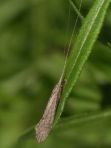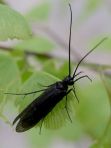
| Trichoptera ~ Caddisflies |
|
Poorly represented in our area because the larvae often prefer cold, clear streams, caddisfly adults resemble moths with very long antennae. The larvae are noted for creating various kinds of cases or shells to protect their bodies.
Many adult caddisflies do not feed, but if they do it is on plant liquids or algae. They have two long appendages on their faces which are the maxillary palps. The aquatic larvae have strong mandibles and may feed on plant or animal matter, either by scraping it off rocks, catching it in webs, or piercing and sucking on fluids. Adult caddisflies have large wings which are usually held tent-like over their abdomens. They are weak fliers. Trichopterans develop through complete metamorphosis: the aquatic larvae form a pupa underwater, then crawl out of the pupal shell in order to emerge into the terrestrial habitat as a winged adult. Larvae and adults occupy different habitats. Size ranges from small to medium, with those in our area being rather on the small side. With very few sightings and individuals in this area, it is difficult to identify adult caddisflies beyond order. However, the aquatic nymphs are more easily distinguished by their types of protective constructions.
|
 Hydropsychidae [net-spinning caddisflies] |
 Leptoceridae [long-horned caddisflies] |
 Philopotamidae [finger-net caddisflies] |
![]()